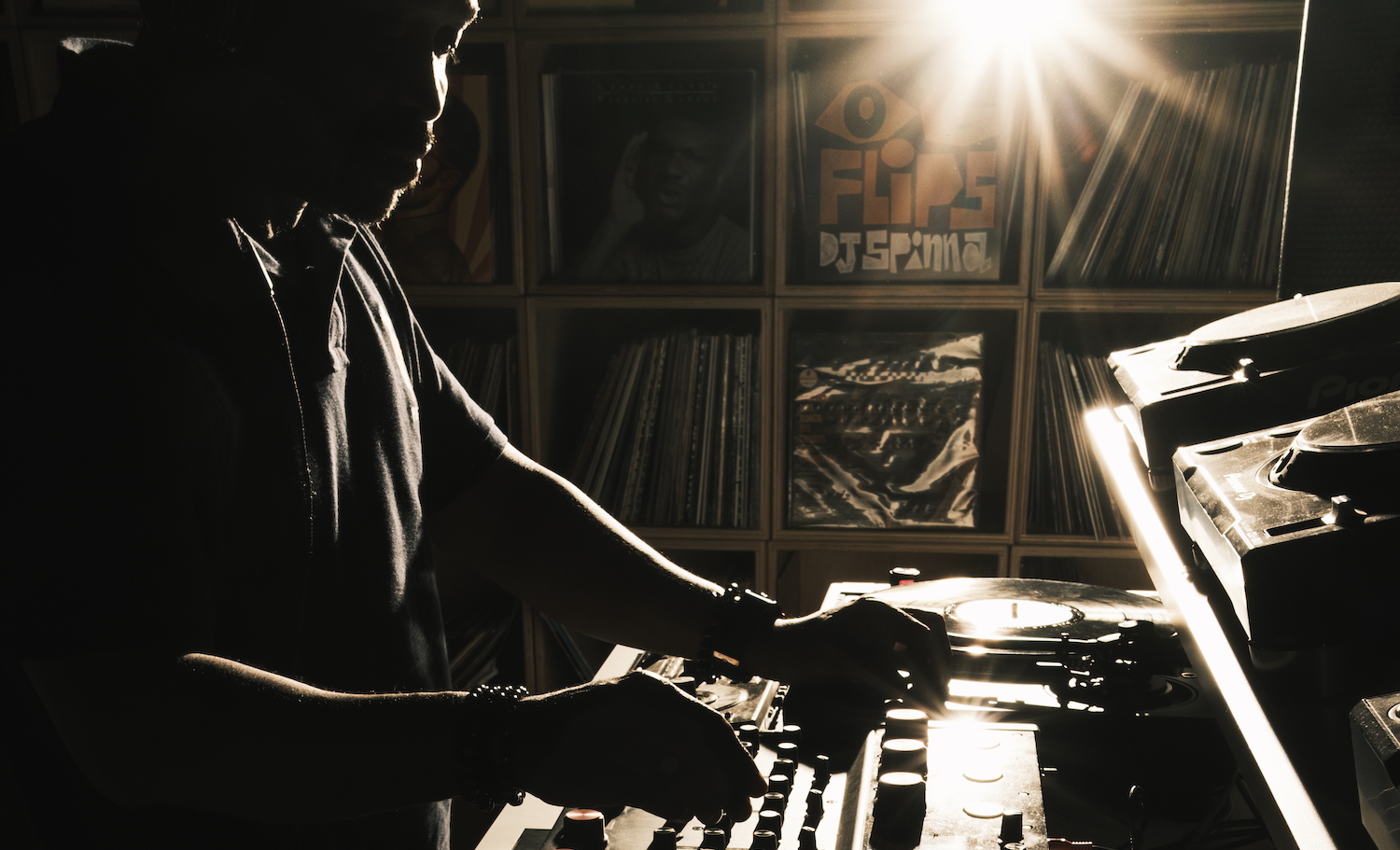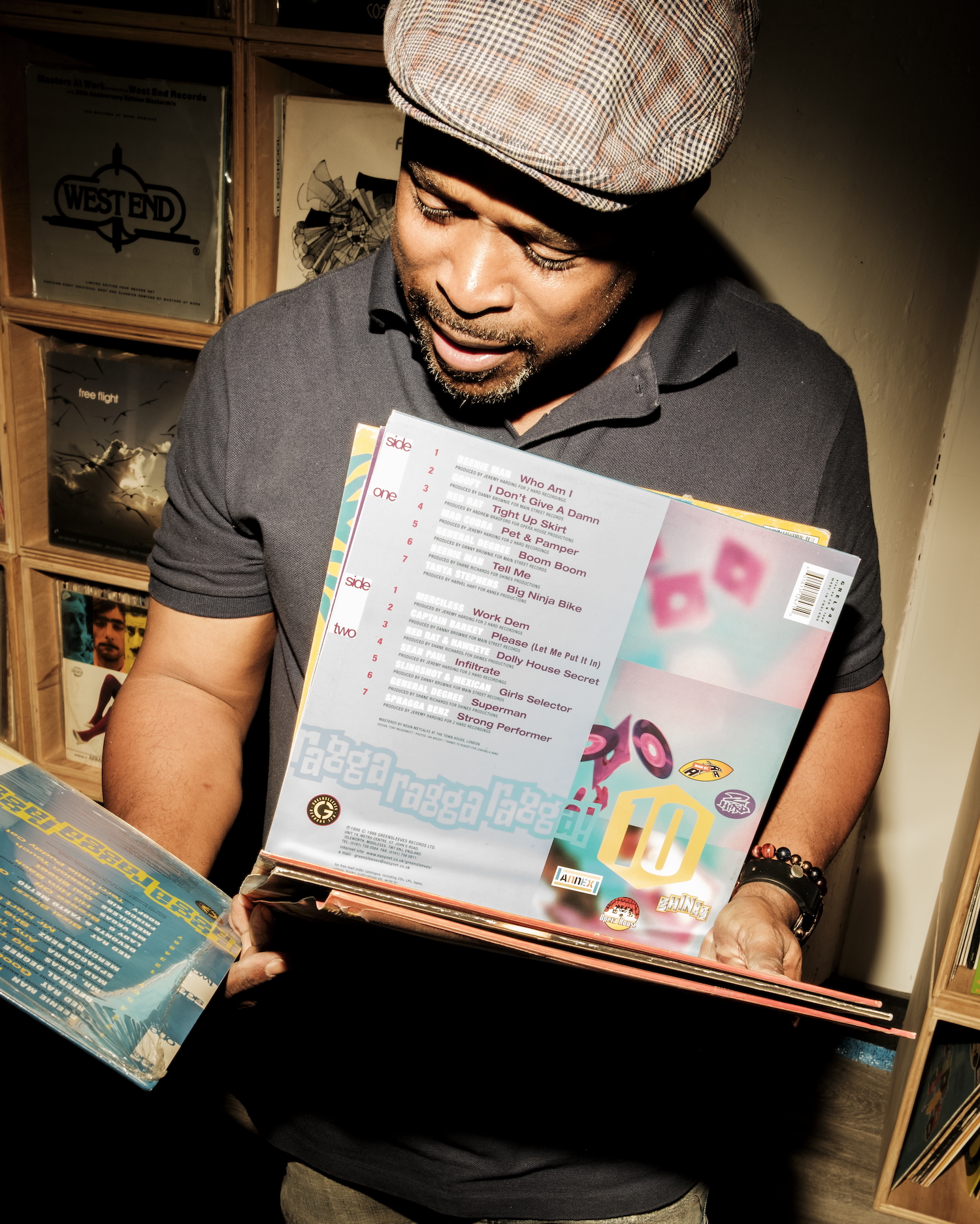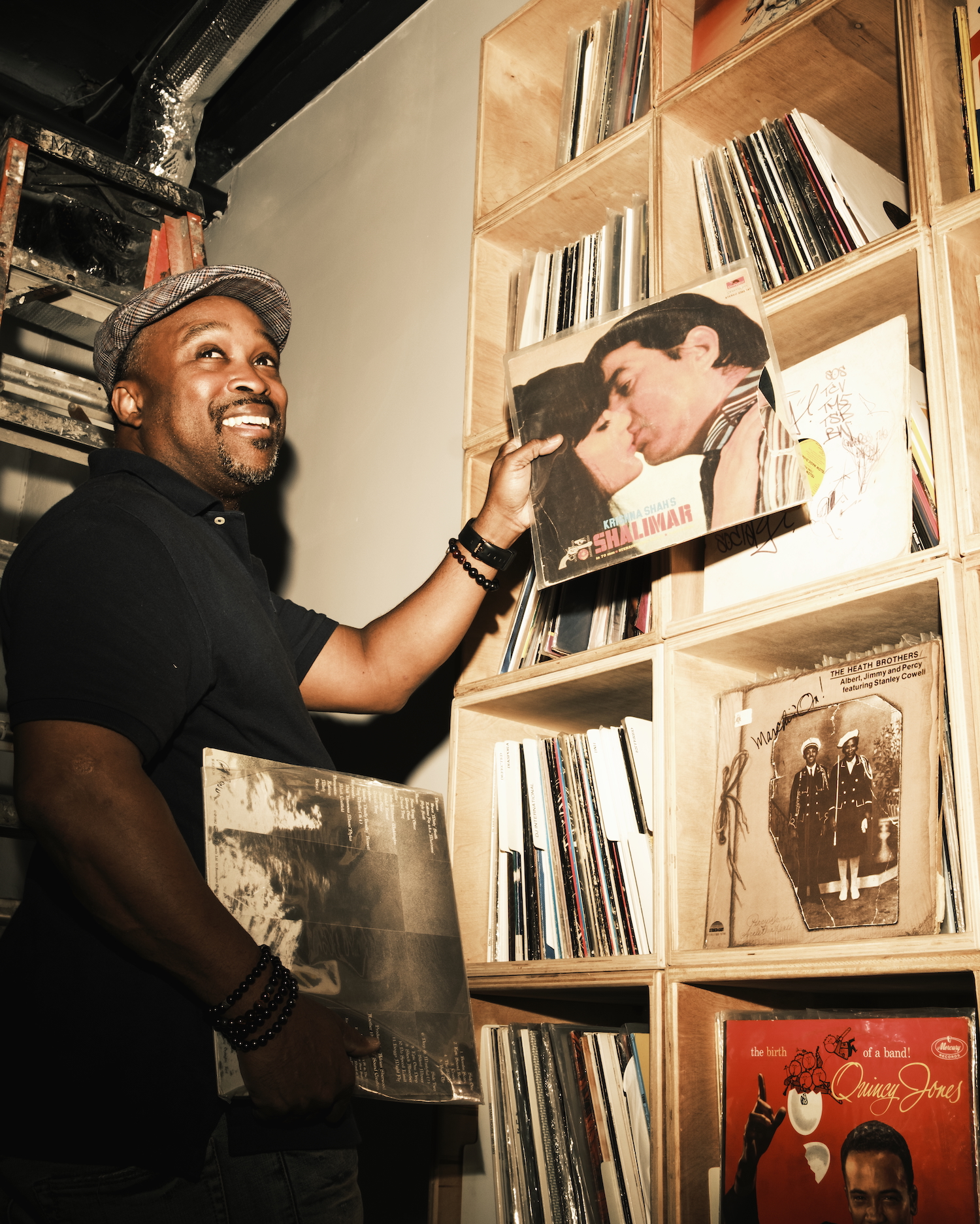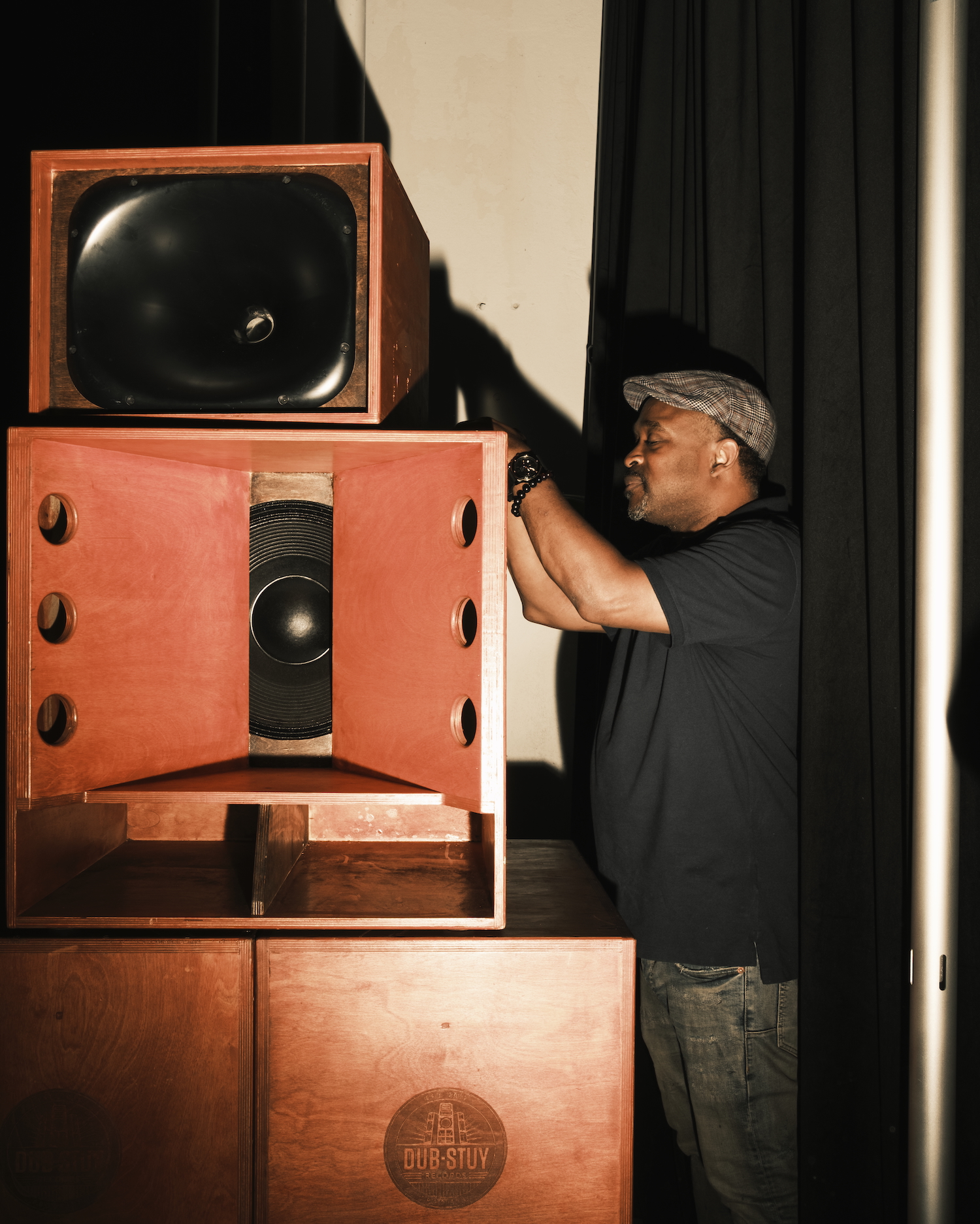
If you live in Brooklyn, chances are good you’ve heard of DJ Spinna, who has been a musical force in New York going back to at least the mid-1990s. However, if you asked a randomly selected panel of five locals why they’d heard of DJ Spinna, you might just get five very different versions of his claim(s) to fame.
The Crown Heights native burst into hip-hop during what’s now remembered as rap’s “golden era” with his strikingly original beats, including remix work for the likes of Das EFX and production for his own rap crew The Jigmastas. At the same time, he was a presence in downtown Manhattan hot spots like Joe’s Pub, Spy Bar, Baby Jupiter, and Guernica, making a name as an elite party DJ with a more expansive approach to music—less Funkmaster Flex, more latter day David Mancuso, or better yet, a Mancuso with the skills to go toe-to-toe with the best battle DJs on the planet.

Photo by Javier E. Piñero
A full-length album for indie stalwart Rawkus Records followed in 1999, featuring both instrumental tracks and verses from the likes of Talib Kweli and future megastar Eminem. Funk Flex himself gave the Jigmastas heavy support in the early days of Hot97, but like his friend and sometimes collaborator Bobbito Garcia, Spinna declined to follow hip-hop into its bottle-popping era. Instead, he charted a more winding route through progressive sub-cultures, leaning into house, with side ventures into jazz and classic soul—a versatility that soon found him in demand for remix projects from iconic labels like Blue Note and Motown. Accordingly, his remix credits include names like Donald Byrd, Eddie Kendricks, Stevie Wonder, and even Michael Jackson. If those last two names are about as major as remix credits can get, dropping them still doesn’t do justice to Spinna’s relation with these artists and their music. It would be closer to say that over the last two decades, they have become almost synonymous.
“Wonder Wrote It came first,” he explains on a recent Tuesday afternoon, when we finally get a chance to talk. Neighbors for years, we have often run into each other on the streets of Brooklyn, where Spinna, born Vincent Williams, is equally likely to be seen dropping his kids off at school or headed to the airport for a headlining appearance at, say, Gilles Peterson’s We Out Here Festival. “It was a mixed CD of Stevie Wonder covers and compositions that weren’t released under his own name–just an underground thing compiled by me and Bobbito. We did two volumes. Then, once the ‘Wonder-Full’ party came to life, we did a legit version with licensed music on a label called Harmless Records out of the UK.”
That was back in 2001, and the Wonder-Full party, launched that year, became so successful that over the subsequent years Stevie himself occasionally showed up to enjoy the vibes or even touch the mic for an impromptu live performance, like one particularly memorable evening at the Manhattan Center in 2008, when by all accounts Stevie sang a Barack Obama presidency into existence. One year after launching Wonder-Full, Spinna applied a similar concept to a Michael Jackson vs. Prince party, which quickly evolved into the event called Soul Slam. “They took on a life of their own, you know?” says Spinna in his low-key way. “I got Prince’s blessing, and once Prince passed away, I started doing Prince parties as well.”
These events more or less drew the blueprint of the tribute party format, but also established Spinna as one of the few musical curators with the depth and range to handle official tributes to artists of this caliber, which is why Spike Lee came calling.
“That relationship goes back to 2009,” says Spinna as we pull together two armchairs near a stage being erected at one end of the industrial loft/studio space he has dubbed the “Spinnaverse”—his base of operations for the last year or so. “He was looking for a DJ for what would be Michael Jackson’s sendoff after he passed away, ‘BK Loves MJ 2009,’” he recalls. “Through many referrals, he was told, ‘Spinna is the guy, ’cause he, he’s been celebrating Michael for a while now and no one does it better.”

Photo by Javier E. Piñero
The Spinnaverse, easily recognizable to Spinna’s 20,000+ Twitch followers as the backdrop of his online sets, is currently being transformed to host Spinnafest 2025, the real-life multi-day event he announced recently. It takes place this coming weekend from September 26-28. That’s really what we are here to discuss, but with a resumé like his, there’s quite a bit of ground that needs to be covered before we dare to ask, what kind of festival does Brooklyn’s most eclectic DJ book himself for?
After all, in this age of granular tracking and digital quantification, Spinna’s most-streamed tracks at the moment we sink into the armchairs include the jazzy, two-step leaning remix (produced in collaboration with Viktor Axelrod AKA Ticklah) that made Shaun Escoffery’s soulful house track “Days Like This” into an electronic music festival anthem, and “Bleepers,” the atmospheric collage of robot bloops and crisp snares from his 1996 Beat Tape, Vol. 1, instrumental hiphop that would fit perfectly into a mix with beats from DJ Krush or J Dilla. For the tens of thousands of followers who might know his full range, there are certainly millions who have streamed one of these or his other highly visible productions, who only know one facet.
So, who is Spinnafest for? And what would it even look like? A B-boy summit, a soul concert, a disco in the spirit of The Loft of Paradise Garage? With names on the bill including the Jigmastas, radio veteran DJ Red Alert, and Renée Neufville (one half of Zhané), not to mention Spike Lee himself, it might be a bit of all of these, but with aspects of a multimedia seminar as well.
“The festival is a three-day weekender where I can showcase some of my talented artist friends,” Spinna says. “So that would be in the form of live performance, visual art. Jamel Shabazz, who’s a photographer, will be here with one of his pieces on display throughout the weekend. Comedy; we have Dean Edwards coming through to perform. DJs; we’ve got Stretch Armstrong, Tony Touch will be here spinning, and I’m also speaking to Red Alert, Jazzy J, and DJ Scratch about their careers as well. Spike Lee will be here for an engaging conversation about the musical side of his career, ’cause he never really talks about music as much as he should. His contribution to music through film is insane.”
Of course, this means transforming the Spinnaverse into a flexible event space that can handle live performances and podcast-style conversations as well as DJ sets, which is no minor undertaking. The first time I see the space, Spinna is deep in conversation with producer and engineer “Bassy Bob” Brockmann, who is offering some professional advice on soundproofing that can accommodate all these needs in a space that will also house a production studio, but the consultation quickly turns into a musical seminar of its own.

Photo by Javier E. Piñero
The first thing you notice when you step into the Spinnaverse is the records—some 30 to 40,000 by my quick guesstimation, with at least that many still in storage elsewhere. “Count the squares and multiply by 90,” he offers, spotting me losing count again and again. The conversation naturally gets sidetracked every time Bob recognizes a project he worked on amongst the colonnades of wax—a body of work which, apparently, comprises most of the records that came out of NY in the ’80s and ’90s, including everyone from Kashif to the Notorious BIG to Debbie Gibson. From there, Spinna starts pulling out more obscure releases from the depths of these artists catalogs and asking questions about their construction. Pretty soon, Bob is explaining how the first time he heard slapback echo applied to disco drums was when he sat in on the engineer-less Larry Levan and Gwen Guthrie sessions that produced their dancefloor classic “Ain’t Nothing Going On But The Rent.” Spinna points out this was doubtless a trick Levan picked up from the techniques dub luminaries Sly & Robbie used on other Guthrie tracks. It’s about this time I give up on an interview for the day, and just start taking notes as these men wax lore in a once-in-a-lifetime conclave.
It’s the pleasantest sort of delay, but also a perfect illustration of the depth and breadth of Spinna’s musical knowledge, which cuts across decades and genres. To some extent, this polymathic quality is a birthright of his family roots—Panamanian of Jamaican extraction—and Brooklyn upbringing, during the prime years of disco and funk cross-germinating with Caribbean sound system culture to produce hip-hop, a mix that got into young Spinna by literal osmosis.
“I can’t even say who was playing it, but putting your speaker in the window and blasting music was a thing,” Spinna says of the musical education his community provided early. “Basement parties, block parties, family gatherings where DJs were present. Panamanians were really big on boat rides in the summertime, and there was always a DJ. By the late seventies, we had our own DJ crew on my block on President Street—there’s a record over there,” he indicates one disc amongst the towering shelves. “They were called the Laser Rock Disco. Those were the guys, my OGs, that I watched and listened to as a kid.”
It doesn’t hurt that his dad also briefly operated a bar in Crown Heights and kept a record collection. “You know, my dad had a modest record collection. Nothing huge, but his younger brother, my uncle, had a much bigger collection. Not a DJ by any means, but I would say I learned more about music going through his records. And that’s across many genres, especially during the seventies and eighties. He had more Caribbean music, more reggae, more oldies like Sam Cooke, Sarah Vaughn, Aretha Franklin, James Brown, moving on into seventies funk. And then even early hip-hop records. He passed away back in 2013, and when I was going through his collections, which I inherited, I was really surprised to see so many early rap records in his collection, cause at that point you would think there’d be a generation gap, but he was open to it, you know: The Fat Boys and Kurtis Blow and Sugar Hill Gang.”

Photo by Javier E. Piñero
There is a satisfying sense of continuity in seeing these slabs of ancestral vinyl inhabiting the space where Spinnafest will take place, as the organizing theme of the eclectic and multimedia lineup seems to be simply maintaining the artistic richness that has inhabited Brooklyn for generations. There’s also a certain full-circle quality to our conversation, as I, like many Brooklynites, first met Spinna and heard him play at his annual backyard parties that were a Fort Greene tradition throughout the 2000s.
“Those backyard parties were really just a continuation of what I experienced growing up, giving back to the community,” he reflects. “We didn’t charge people for that. It was called Rebel Music, and it always happened around 4th of July weekend. We stopped doing them around in 2011, but we had a good eight-year run. Everything that I do is a means of engaging the community. You know, especially old school Brooklyn. And just people who have supported us, my wife Keita and I, through the decades. Back then, it was just a way of giving back to our social network, the creative community of Brooklyn–Fort Greene, Bed-Stuy, Crown Heights–people we grew up with. Just giving back and making sure we stay connected to everybody.”
I can’t help but point out that Spinnafest is in some ways a throwback, or perhaps a more polished successor, to the bohemian backyard bashments of those days. “We are living in a time now where a lot of us who have been here, who have cultivated a lot of the nightlife and cultural happenings [in Brooklyn] are being excluded and pushed out from venues,” Spinna affirms, as he takes a break from discussing different configurations of mammoth speaker stacks with the guys from DubStuy Sound. “This space is a means to stay connected and keep that energy alive, but also serves as a multi-faceted, multi-functional space where it’s not just about music. Hopefully, we’ll bring in film, bring in literature, photo shoots, gallery spaces for art, and what have you, to stay connected to the creative community and give people opportunities to nurture their art.’”
In my background research for this profile, I continuously came across AllMusic’s bio, which begins this way: “DJ Spinna’s accomplishments surpass those of most DJs, yet he remained strictly an underground artist despite his astonishing talent.” It’s hard to assess what exactly “underground” might fit with a producer who has remixed the King of Pop and picked up millions of streams for his original creations. But perhaps a better descriptor for Spinna’s particular and perfectionist approach to his music career is not underground, but “independent.” Almost out of the gate, everything from the labels he signed with, to the clubs and festivals he played, to the outlets he broadcast through, have been those that allowed him to maximize his agency and creative control. With that in mind, I may have to revise my headline for this piece. With Spinnafest, DJ Spinna is not getting a festival. As with everything else in his long career, he’s building one himself.
The post Stepping Into The Spinnaverse appeared first on BKMAG.

